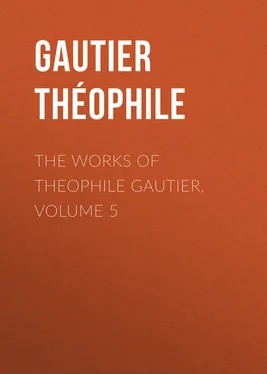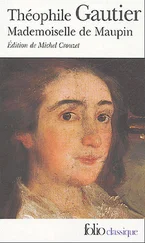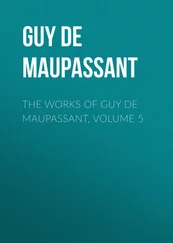Théophile Gautier - The Works of Theophile Gautier, Volume 5
Здесь есть возможность читать онлайн «Théophile Gautier - The Works of Theophile Gautier, Volume 5» — ознакомительный отрывок электронной книги совершенно бесплатно, а после прочтения отрывка купить полную версию. В некоторых случаях можно слушать аудио, скачать через торрент в формате fb2 и присутствует краткое содержание. Жанр: foreign_antique, foreign_prose, на английском языке. Описание произведения, (предисловие) а так же отзывы посетителей доступны на портале библиотеки ЛибКат.
- Название:The Works of Theophile Gautier, Volume 5
- Автор:
- Жанр:
- Год:неизвестен
- ISBN:нет данных
- Рейтинг книги:3 / 5. Голосов: 1
-
Избранное:Добавить в избранное
- Отзывы:
-
Ваша оценка:
- 60
- 1
- 2
- 3
- 4
- 5
The Works of Theophile Gautier, Volume 5: краткое содержание, описание и аннотация
Предлагаем к чтению аннотацию, описание, краткое содержание или предисловие (зависит от того, что написал сам автор книги «The Works of Theophile Gautier, Volume 5»). Если вы не нашли необходимую информацию о книге — напишите в комментариях, мы постараемся отыскать её.
The Works of Theophile Gautier, Volume 5 — читать онлайн ознакомительный отрывок
Ниже представлен текст книги, разбитый по страницам. Система сохранения места последней прочитанной страницы, позволяет с удобством читать онлайн бесплатно книгу «The Works of Theophile Gautier, Volume 5», без необходимости каждый раз заново искать на чём Вы остановились. Поставьте закладку, и сможете в любой момент перейти на страницу, на которой закончили чтение.
Интервал:
Закладка:
"Shall I open the sarcophagus?" said Argyropoulos, after Lord Evandale and Doctor Rumphius had had time to admire the beauty of the Golden Hall.
"Unquestionably," replied the nobleman; "but take care not to chip the edges of the cover as you put in your crow-bars, for I propose to carry off the tomb and present it to the British Museum."
The whole company bent their efforts to displacing the monolith. Wooden wedges were carefully driven in, and presently the huge stone was moved and slid down the props prepared to receive it. The sarcophagus having been opened, showed the first bier hermetically sealed. It was a coffer adorned with paintings and gilding, representing a sort of shrine with symmetrical designs, lozenges, quadrilles, palm leaves, and lines of hieroglyphs. The cover was opened, and Rumphius, who was bending over the sarcophagus, uttered a cry of surprise when he discovered the contents of the coffin, having recognised the sex of the mummy by the absence of the Osiris beard and the shape of the cartonnage. The Greek himself appeared amazed. His long experience in excavations enabled him to understand the strangeness of such a find. The valley of Biban el Molûk contains the tombs of kings only: the necropolis of the queens is situated farther away, in another mountain gorge. The tombs of the queens are very simple, and usually consist of two or three passage-ways and one or two rooms. Women in the East have always been considered as inferior to men, even in death. Most of these tombs, which were broken into at a very distant period, were used as receptacles for shapeless mummies carelessly embalmed, which still exhibit traces of leprosy and elephantiasis. How did this woman's coffin come to occupy this royal sarcophagus, in the centre of this cryptic palace worthy of the most illustrious and most powerful of the Pharaohs?
"This," said the doctor to Lord Evandale, "upsets all my notions and all my theories. It overthrows the system most carefully built upon the Egyptian funeral rites, which nevertheless have been so carefully followed out during thousands of years. No doubt we have come upon some obscure point, some forgotten mystery of history. A woman did ascend the throne of the Pharaohs and did govern Egypt. She was called Tahoser, as we learn from the cartouches engraved upon older inscriptions hammered away. She usurped the tomb as she usurped the throne. Or perhaps some other ambitious woman, of whom history has preserved no trace, renewed her attempt."
"No one is better able to solve this difficult problem than you," said Lord Evandale. "We will carry this box full of secrets to our boat, where you will, at your leisure, decipher this historic document and read the riddle set by these hawks, scarabæi, kneeling figures, serrated lines, winged uræus, and spatula hands, which you read as readily as did the great Champollion."
The fellahs, under the orders of Argyropoulos, carried off the huge coffer on their shoulders, and the mummy, performing in an inverse direction the funeral travel it had accomplished in the days of Moses, in a painted and gilded bari preceded by a long procession, was embarked upon the sandal which had brought the travellers, soon reached the vessel moored on the Nile, and was placed in the cabin, which was not unlike, so little do forms change in Egypt, the shrine of the funeral boat.
Argyropoulos, having arranged about the box all the objects which had been found near it, stood respectfully at the cabin door and appeared to be waiting. Lord Evandale understood, and ordered his valet to pay him the twenty-five thousand francs.
The open bier was placed upon rests in the centre of the cabin; it shone as brilliantly as if the colours had been put on the day before, and framed in the mummy, moulded within its cartonnage, the workmanship of which was remarkably fine and rich. Never had ancient Egypt more carefully wrapped up one of her children for the eternal sleep. Although no shape was indicated by the funeral Hermes, ending in a sheath from which stood out alone the shoulders and the head, one could guess there was under that thick envelope a young and graceful form. The gilded mask, with its long eyes outlined with black and brightened with enamel, the nose with its delicate nostrils, the rounded cheek-bones, the half-open lips smiling with an indescribable, sphinx-like smile, the chin somewhat short in curve but of extreme beauty of contour, presented the purest type of the Egyptian ideal, and testified by a thousand small, characteristic details which art cannot invent, to the individual character of the portrait. Numberless fine plaits of hair, tressed with cords and separated by bandeaux, fell in opulent masses on either side of the face. A lotus stem, springing from the back of the neck, bowed over the head and opened its azure calyx over the dead, cold brow, completing with a funeral cone this rich and elegant head-dress.
A broad necklace, composed of fine enamels cloisonnés with gold and formed of several rows, lay upon the lower portion of the neck, and allowed to be seen the clean, firm contour of two virgin breasts like two golden cups.
The sacred ram-headed bird, bearing between its green horns the red disc of the setting sun and supported by two serpents wearing the pschent and swelling out their hoods, showed on the bosom of the figure its monstrous form full of symbolic meaning. Lower down, in the spaces left free by the crossed zones, and rayed with brilliant colours representing bandages, the vulture of Phra, crowned with a globe, with outspread wings, the body covered with symmetrically arranged feathers, and the tail spread out fanwise, held in its talons the huge Tau, emblem of immortality. The funeral gods, green-faced, with the mouths of monkeys or jackals, held out with a gesture hieratic in its stiffness the whip, the crook, and the sceptre. The eye of Osiris opened its red ball outlined with antimony. Celestial snakes swelled their hoods around the sacred discs; symbolical figures projected their feathered arms; and the two goddesses of the Beginning and the End, their hair powdered with blue dust, bare down to below the breasts and the rest of the body wrapped in a close-fitting skirt, knelt in Egyptian fashion on green and red cushions adorned with heavy tufts.
A longitudinal band of hieroglyphs, springing from the belt and running down to the feet, contained no doubt some formal funeral ritual, or rather, the names and titles of the deceased, a problem which Dr. Rumphius promised himself to solve later.
The character of the drawing, the boldness of the lines, the brilliancy of the colours in all these paintings denoted in the plainest manner to a practised eye that they belonged to the finest period of Egyptian art. When the English nobleman and his companion had sufficiently studied this outer case, they drew the cartonnage from the box and set it up against the side of the cabin, where the funeral form, with its gilded mask, presented a strange spectacle, standing upright like a materialised spectre and with a seeming attitude of life, after having preserved so long the horizontal attitude of death on a basalt bed in the heart of the mountain, opened up by impious curiosity. The soul of the deceased, which had reckoned on eternal rest and which had taken such care to preserve its remains from violation, must have been moved, beyond the worlds, in the circuit of its travels and transmigrations.
Dr. Rumphius, armed with a chisel and a hammer, to separate the two parts of the cartonnage of the mummy, looked like one of those funeral genii which wear a bestial mask and which are seen in the paintings of the hypogea crowding around the dead in the performance of some frightful and mysterious rite; the clean profile of Lord Evandale, calm and attentive, made him look like the divine Osiris awaiting the soul to be judged.
Читать дальшеИнтервал:
Закладка:
Похожие книги на «The Works of Theophile Gautier, Volume 5»
Представляем Вашему вниманию похожие книги на «The Works of Theophile Gautier, Volume 5» списком для выбора. Мы отобрали схожую по названию и смыслу литературу в надежде предоставить читателям больше вариантов отыскать новые, интересные, ещё непрочитанные произведения.
Обсуждение, отзывы о книге «The Works of Theophile Gautier, Volume 5» и просто собственные мнения читателей. Оставьте ваши комментарии, напишите, что Вы думаете о произведении, его смысле или главных героях. Укажите что конкретно понравилось, а что нет, и почему Вы так считаете.












